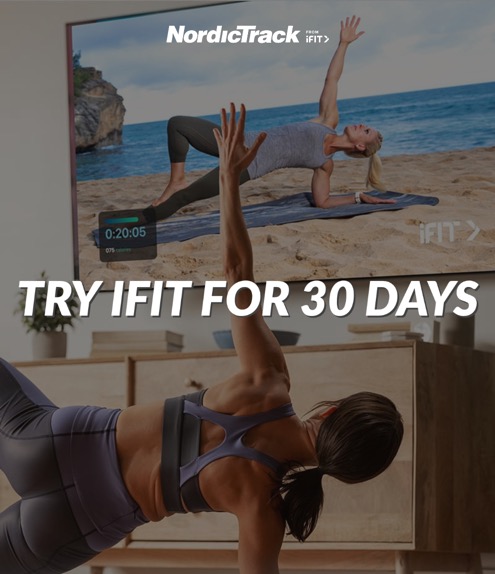
Should you go with an exercise bike or a rower for your home gym?
You may be asking yourself that exact question and need help choosing between an exercise bike vs. a rowing machine.
Fortunately, you’ve landed on this article, which will hopefully help you narrow down your options.
To ensure you choose the right equipment for your needs, we’re going over everything you need to know about both modalities.
This guide will cover more about the different types of bikes and rowers, their health benefits, the muscles each one works, and so much more, as you can see from the table of contents below:
- The Top Health Benefits of Exercise Bikes & What Muscles They Work
- The 3 Main Types of Exercise Bikes
- The Top Health Benefits of Rowing Machines & The Muscles They Work
- The 3 Main Types of Rowing Machines
- Exercise Bike vs. Rowing Machine: Which One is Right for You?
- How to Get the Most Out of Your Exercise Equipment
By the end of reading this, you should have a better idea of which one could be right for your health and fitness goals.
So, what are the differences, and what do you need to know about these two cardio machines?
Let’s find out!
Everything You Need to Know About Exercise Bikes
Before comparing the two, it pays to know more about each one, starting with exercise bikes.
Here’s why exercise bikes are a great form of cardio:
The Top Health Benefits of Exercise Bikes & What Muscles They Work
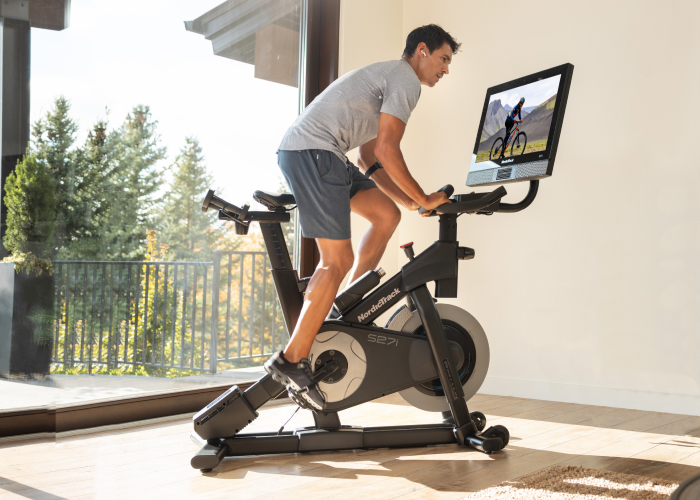
Although exercise bikes may not always look like their road-friendly counterparts, they share many of the same health benefits.
We discussed the top health benefits of exercise bikes in a previous article, so we’ll only share a quick summary here. When you’re done reading this one, we encourage you to check out that article for more in-depth information.
In short, consistently using an exercise bike may help:
- Increase your calorie burn (potentially up to 14 hours later) [1]
- Improve your body composition, cholesterol, and triglyceride levels [2]
- Increase your muscle strength and stamina [3]
- Improve cardiovascular health [4]
- Decrease joint pain [5]
Cycling is also a low-impact form of cardio that places less strain on your muscles and joints compared to other exercises since you’re in a seated position. [3]
And, thanks to indoor cycling, you can ride no matter the weather outside and you can adjust the intensity of your rides at a moment’s notice.
Because cycling uses the large muscles in the lower half of your body, including your quadriceps, hamstrings, calves, and glutes, it offers a powerful way to exercise despite being low-impact.
Since these muscles are so big, when they’re activated, they can potentially burn a significant amount of calories, which may be helpful if weight loss is your goal. [1]
Visit the article mentioned a moment ago to learn more about those benefits, find answers to commonly asked questions, discover the differences between the exercise bike types (more on this next), and see how to adjust your seat properly.
The 3 Main Types of Exercise Bikes
Another great perk about indoor exercise bikes is that they come in several styles, each offering something different. So, you can find one that comfortably fits you.
If you’re looking to add an exercise bike to your home gym, here are the most popular options to choose from:
1. Studio-Style Exercise Bike
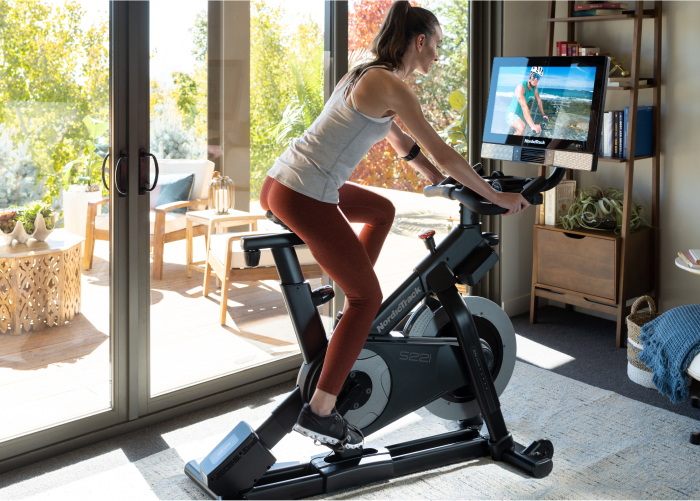
Studio-style exercise bikes are designed for high-intensity workouts and are similar to those you’d see in person in a cycling class.
They have varying resistance levels to help you quickly increase or decrease the intensity, and they position you upright and forward like a traditional outdoor bike.
The NordicTrack S27i and S22i also feature the ability to incline and decline, which mimics cycling up and down hills and offers a real-world experience.
Whether you’re looking for a studio-style experience or want it to feel more like real-world terrain without leaving your home, this exercise bike could be a great fit.
To learn more about the S27i or S22i, visit those links now.
2. Recumbent Bike
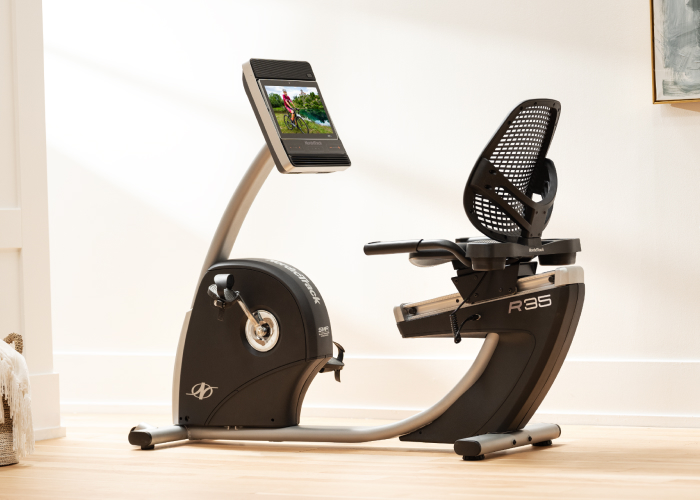
Recumbent exercise bikes place users in a seated, reclined position, which offers more back support.
This seated and supported position places less stress on your back and joints compared to other exercise bikes. [6]
In a recumbent bike, your legs are also out in front of you rather than below you, like they would be with a studio-style or upright stationary bike. Some people find this more comfortable than being completely vertical and upright.
To learn about the NordicTrack Commercial R35 recumbent Exercise bike, visit that link now.
3. Upright Stationary Exercise Bike
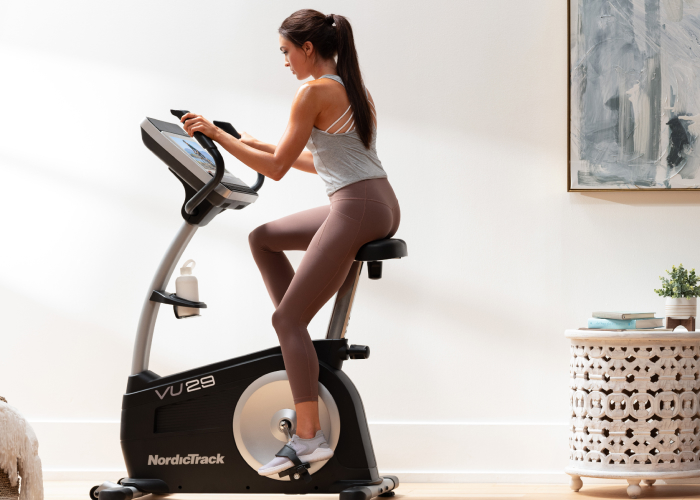
When you imagine a stationary bike, you may think of an upright exercise bike.
They position users vertically, hence the name, and mimic what riding beach cruisers or traditional bikes is like where your back is more upright than leaning forward.
An upright stationary bike may be perfect for people who want an authentic bike riding experience but don’t need the high intensity of a studio-style bike.
To learn about NordicTrack’s Commercial VU 29 upright stationary bike, visit that link now.
You can also learn more about these exercise bikes in-depth and everything else to consider when buying one by visiting our Exercise Bike Buying Guide.
Now that you know more about exercise bikes, let’s move on to rowers.
Everything You Need to Know About Indoor Rowing Machines
While you may have the option to jump on a bicycle and ride around your neighborhood or at home with a stationary bike, you may not have access to open waterways, which is why an indoor rowing machine can bring something new to your home gym.
And that’s just one reason why rowers are a great addition to any home gym.
Here are a few more reasons to consider using one:
The Top Health Benefits of Rowing Machines & The Muscles They Work

Rowing machines are a great, low-impact form of cardio that uses muscles in both your upper and lower body, creating a total body workout with each row.
Rowers also naturally get your heart pumping, which increases your heart rate, making them excellent for improving cardiovascular fitness.
And that’s still just the beginning of their health perks.
We published an article on the health benefits of rowing, so once again, we’ll share a summary here. We encourage you to check that out when you’re done here.
In short, rowing machines may help:
- Improve joint strength [7]
- Decrease body fat [8]
- Produce a comparable calorie burn to other cardio machines [9]
- Increase strength
Another article we published answered the question, what muscles do rowing machines work? And the answer was astonishing: over 16 different muscles in the back, core, legs, and arms.
Those muscles include the following:
- Biceps
- Deltoids
- Erector spinae
- Forearm muscles
- Gastrocnemius
- Gluteus maximus
- Hamstrings
- Latissimus dorsi
- Obliques
- Pectoral
- Rectus abdominis
- Rhomboids
- Tibialis anterior
- Trapezius
- Triceps
- Quadriceps
You can visit that article next to learn more about the muscles rowers work, answers to commonly asked questions about indoor rowing machines, proper rowing form, and more.
The 3 Main Types of Rowing Machines
Similar to exercise bikes, there are different styles of rowing machines.
However, unlike stationary bikes, all rowers position users in the same seated position. The key difference between the options is the type of resistance used, which we’ll explore now.
These three types of resistance are the most popular for rowers:
1. Water
Want to feel like you’re actually rowing across a serene lake?
Compared to the other options, water rowers, as the name suggests, simulate as closely as possible what rowing in real life is like.
That’s because a water rowing machine has its flywheel immersed in a water tank, which means you get to work against natural resistance every time you pull the handle.
Instead of using a fan and air for resistance, like other types of rowers, water rowing machines use, you guessed it, water and a paddle that churns through the water just like you would in real life.
This combination of paddling through the water creates resistance each time you pull the handlebar towards your chest.
Like an air rower, the harder you pull, the greater the resistance as you try to churn the water faster.
And, since they don’t have that large fan blowing when they’re being used, water rowers tend to be a bit quieter than air rowers.
However, there are some drawbacks to water rowing machines.
With the large water tank at the front of the machine, water rowers are often bigger than air or magnetic rowers, which isn’t ideal if your home gym is small.
You may also be wondering, what about the water?
The tank’s water needs to be treated periodically to keep it clean and reduce bacteria buildup.
Because of that, the size and water treatment needed are two big factors to consider when browsing rowers online.
Do you have the space for a big rower?
And do you have the time to keep the tank clean?
If the answer to those questions is no, then you may want to look into one of the following two options:
2. Air
Air rowers may not offer that same “splash” as water rowing machines, but they are another common type of rower, one you’ll often see in commercial gyms.
Instead of having a water tank, the flywheel on this type of rower uses a fan that blows faster the harder you pull.
You can usually adjust the resistance levels on air rowers by changing the damper settings. This allows either more or less air into the flywheel to increase or decrease the resistance.
While not identical to rowing on water, air rowers create a similar experience to actual rowing since you have to battle the wind resistance with each handlebar pull.
They’re also a more affordable option than the other rower types, which is why they’re often used at commercial facilities.
One of the drawbacks of air rowers is that they’re often noisier than the other two types of rowers, and the noise only gets louder the harder and faster you row.
If you’re considering buying a rower for home use, consider whether having a noisy machine is a deal breaker. The other two types of rowers may be better suited for you if it is.
3. Magnetic

The third common type of rowing machine is the magnetic rower.
With this type of rower, two strong magnets are attached to the flywheel, and the distance between them creates resistance.
If you’ve ever tried to force magnets together and felt them repel one another, you’ve seen this type of resistance in action.
The closer the magnets are to the flywheel, the stronger the resistance will be.
Depending on the type of magnetic rower, the magnets are either moved mechanically with an adjustable knob or digitally with a tap of a button on a console.
One of the best features of this type of rower is that there’s far less noisy friction than water or air rowers, which naturally creates a quieter experience.
Using magnets for resistance instead of moving water or air creates a more controllable and consistent resistance.
If you’re starting with rowing or you’re looking to progress your fitness level strategically, this type of rower offers the perfect level of ease and adjustability.
Exercise Bike vs. Rowing Machine: Which One is Right for You?

Now that you know what each machine has to offer, it’s time to address the big question: When it comes to an exercise bike vs. a rowing machine, is one really better than the other?
The truth is that these are different workouts for different needs, which means the final decision is all up to you.
To help you decide, here are a few more things to consider:
Determine the Type of Workout You’re Looking For
Do you want a leg-focused workout or more of a total-body experience?
Answering this question alone could help you narrow down your options.
While you could engage your upper body when standing upright on an exercise bike, you’ll use your upper body and core far more with each row on a rowing machine.
Both machines may help build lower body strength, so if you’re unsure, keep reading to help you discover the right fit.
Consider Your Personal Preferences and Health Goals
Since both an exercise bike and a rowing machine provide cardiovascular benefits, some of the comparison comes down to personal preference.
This includes considering things like:
- How do you prefer to work out?
- Which one sounds more enjoyable to you?
- What are your health goals?
- How would you like to integrate this new machine into your routine?
Remember, the difference between an exercise bike and a rowing machine doesn’t matter if you won’t actually use the machines, so choosing something you’ll enjoy is key here.
If rowing consistently sounds relaxing and meditative or you’d like a full-body workout, a rower may be better suited.
But an exercise bike could be a better fit if you prefer the thrill of riding around and racking up miles.
Before you decide, consider this next point first:
How Much Space You Have In Your Home Gym
Most home gyms don’t have infinite space, so it’s important to consider the footprint of each exercise machine and the room you have at home.
For example, the NordicTrack S27i Studio Cycle has the following dimensions: 57″ L X 28″ W X 65″ H.
The Commercial R35 recumbent exercise bike comes in slightly longer at 68.22″ L X 23.69″ W X 53.42″ H.
The Commercial VU 29 upright bike is the most compact compared to the other bikes at 41.49″ L X 24.86″ W X 55.29″ H.
Meanwhile, the NordicTrack RW900 rower has these dimensions: 82″ L x 22″ W x 54″ H.
The RW700 rower is slightly smaller at 81.5″ L x 21″ W x 49″ H.
The exercise bike may be best for home gyms with shorter spaces that are smaller in length, while the rowing machine is better for home gyms that have long, narrower sections of available space.
However, within the exercise bike selection, recumbent bikes will take up a bit more space length-wise than studio-style bikes would.
That’s why measuring your space is important to see if one machine will fit better.
The Verdict: Exercise Bikes vs. Rowing Machines
Choosing an exercise bike versus a rower is ultimately yours, but we hope everything we’ve pointed out in this article can help you make the right choice.
If you can’t decide, you could buy both pieces of exercise equipment to expand your home gym.
Alternating between modalities, including cycling through using a treadmill or elliptical too, keeps things interesting and engages different muscles.
No matter what, any modality will be helpful for reaching your health and fitness goals so long as you enjoy working out on them and stay consistent with them.
The key is experimenting with different modalities to find the ones you truly enjoy.
If you have other exercise equipment or cardio routines you love, there’s no need to replace them when you get a new machine. Instead, consider ways to integrate the new equipment into your weekly workouts.
To take things a step further, consider this next tip:
How to Get the Most Out of Your Exercise Equipment

No matter which equipment you use, consider using iFIT, a separate paid subscription service that helps you get the most out of your exercise equipment.
iFIT gives you access to an expansive and continually growing library of workouts both on and off your machine.
Enjoy guided workouts that take you to stunning locations around the world. Expert iFIT Trainers coach you every step of the way, giving you pointers to help you progress and tips to ensure you’re using proper form.
One-of-a-kind features like SmartAdjust™ and ActivePulse™ (the latter is only available on treadmills) deliver personalized training right to your doorstep.
SmartAdjust™ automatically adjusts your exercise equipment’s speed and incline to match what the iFIT Trainer on screen has programmed for the workout.
ActivePulse™, on the other hand, uses an external heart rate monitor (sold separately) to keep you moving in your target heart rate zone.
Both features are only available with an active iFIT membership, which you can learn more about by visiting that page.
Another great feature of the iFIT app is that you can continue to work out even when you’re away from home and your exercise equipment.
Simply log in, choose the next workout, and keep going on your fitness journey.
iFIT opens up a world of opportunities, helping you check off fitness goals and bucket list locations.
Visit this link now to learn more about iFIT.
Exercise Bikes vs. Rowers: Choose One or Both Today
Whether you want to cycle your heart out on an exercise bike or row, row, row your exercise time away on a rowing machine, one thing is clear: you really can’t go wrong with either one.
Both pieces of equipment come with powerful health perks as long as you’re consistent with them.
If you’re just starting out, you may find a stationary bike is more accessible to ease into as a beginner, while a rower might take some time to get used to.
No matter what, choose the piece of equipment that you’ll enjoy using. You’ll find it’s far easier to stay consistent, and after some time, you’ll likely find that you look forward to working out.
If you’re on the fence about which one to go with, why not try each one to see which suits you better?
You can use the links below to learn more about our exercise bikes and rowers:
While we may not have officially settled the debate on exercise bikes vs. rowers, we hope you found this article helpful.
We look forward to hearing all about your fitness journey once you decide which piece of exercise equipment to go with.
References
- https://pubmed.ncbi.nlm.nih.gov/21311363/
- https://pubmed.ncbi.nlm.nih.gov/20585735/
- https://www.betterhealth.vic.gov.au/health/healthyliving/cycling-health-benefits
- https://pubmed.ncbi.nlm.nih.gov/27364407/
- https://pubmed.ncbi.nlm.nih.gov/33167714/
- https://prowellness.childrens.pennstatehealth.org/7-great-benefits-of-a-stationary-bike-workout/
- https://pubmed.ncbi.nlm.nih.gov/25226943/
- https://www.ncbi.nlm.nih.gov/pmc/articles/PMC4564707/
- https://www.health.harvard.edu/diet-and-weight-loss/calories-burned-in-30-minutes-for-people-of-three-different-weights
Disclaimer: The primary purpose of this blog post is to inform and entertain. Nothing on the post constitutes or is intended to be a substitute for professional medical advice, prevention, diagnosis, or treatment. Reliance on any information provided on the blog is solely at your own risk. Always seek the advice of your physician or other qualified health provider with any questions you may have regarding a medical condition, and please consult your doctor or other health care provider before making any changes to your diet, sleep methods, daily activity, or fitness routine. Do not disregard professional medical advice or delay seeking it because of information available on this blog. NordicTrack assumes no responsibility for any personal injury or damage sustained by any recommendations, opinions, or advice given in this article. Always follow the safety precautions included in the owner’s manual of your fitness equipment.


